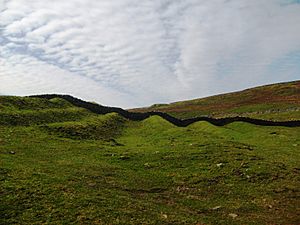Whitley Castle facts for kids

Whitley Castle (also known as Epiacum) is a large, unusually shaped Roman fort. It is located north-west of Alston, Cumbria, England. The Roman Army first built this fort in the early 2nd century AD. It was partly torn down and rebuilt around 200 AD.
Historians believe the fort was built for two main reasons. First, it helped protect lead mining in the area. Second, it supported the border defenses of Hadrian's Wall. Most Roman forts are rectangular, like a playing card. But Whitley Castle is shaped like a lozenge (a diamond) to fit the land. Many banks and ditches surround its stone walls. This makes it one of the most complex forts in the entire Roman Empire.
Experts have studied the site over the years. Thomas Sopwith surveyed it in the 1800s. R.G. Collingwood studied it in the 1900s. In 2012, Durham University used special equipment to map the ground. However, the fort has not been fully dug up yet.
Archaeologists have found many interesting things here. They found altars with messages carved into them. One altar was for Hercules from a Roman army group called Legio VI Victrix. This group was usually based in Eboracum (York). Another altar was for Apollo from the 2nd Cohort of Nervians. This was a group of helper soldiers called auxiliaries. Other finds include old shoes, coins, pottery pieces, beads, nails, and a bronze handle shaped like a dolphin.
Whitley Castle (Epiacum) is also mentioned in a book. It is the setting for a made-up battle in the 2018 novel War of the Wolf. This book was written by Bernard Cornwell. It is part of his Saxon Stories series.
Contents
What's in a Name?
Even though we call it Whitley Castle today, the Romans knew this fort as Epiacum. The ancient writer Ptolemy mentioned it in his book Geography. He said it was the first town in the land of the Brigantes tribe. This tribe lived in northeastern England.
The Latin name Epiacum likely came from a local British name. This name was probably *Epiakon. It meant "the property or estate of Epios." Epios might have been a local leader or chief of the Brigantes tribe. The name might also come from a Celtic word, epos, which means "horse."
Where is Whitley Castle?
Whitley Castle sits about 1,000 feet (300 meters) above sea level. It is in the Pennine hills. This area is on the southern edge of Northumberland, near its border with Cumbria. You can find it west of the modern A689 road. It is also right next to the Pennine Way, a long walking path.
During the Roman era, Epiacum was about 15 miles (24 km) south of Hadrian's Wall. It was also about 20 miles (32 km) north of the main road. This road ran between Luguvalium (Carlisle) in the north-west and Eboracum (York) in the south-east.
A Roman road called the Maiden Way connected Whitley Castle to other forts. It went north to the fort of Magnae (Carvoran) on Hadrian's Wall. It also went south to the fort of Bravoniacum (Kirkby Thore). This southern fort was on the Carlisle-York road.
Whitley Castle is one of the most remote Roman sites in Britain. This might be why it has not been fully dug up. It also helps explain why so much of it has survived over time. The fort is on a diamond-shaped spur of high ground. This land is part of Castle Nook hill farm. Sheep graze on the grass here. The remains of the fort are hidden under the grass. They are easiest to see in pictures taken from the air. The Roman fort itself covers about 4 acres (1.6 hectares). Outside the fort, there are many defensive ditches in circles.
The fort was probably placed here to control the area near Alston. This area had important lead mines. The fort also helped support the defenses of Hadrian's Wall.
History of the Fort
Epiacum was built early in the 2nd century AD. It was partly destroyed and rebuilt around 200 AD. This destruction happened around the time northern tribes rebelled in 196 AD. The fort was changed or completely rebuilt again around the year 300. It seems there was an Iron Age fort here first. Then came a temporary Roman camp. After that, the permanent fort was built.
In some ways, Epiacum was a typical Roman fort. Inside its walls, there were straight roads that crossed each other. There was a main office building called the Praetorium. The commander's house was also there. There were barracks for the auxiliary soldiers and granaries to store food. As was common, there was a bath house and a temple outside the walls. The temple was dedicated to the Emperor Caracalla. An altar to Mithras was found, and another one for Hercules.
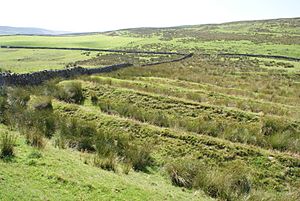
However, Epiacum has two very special features. First, the Roman engineers changed the usual rectangular design. They made it a diamond or parallelogram shape to fit the land. The buildings inside the fort also have this unusual shape. Six barracks were placed behind the main office building. Four more were in front of it. All of this fit into a small area of about 1.25 hectares (3.1 acres).
Second, the fort's wall is surrounded by many defensive features. There are four steep ditches and banks around the hill spur. On the uphill side of the spur, there are seven such ramparts. These are the most complex earthworks of any known Roman fort. They include many banks and ditches outside the usual stone walls.
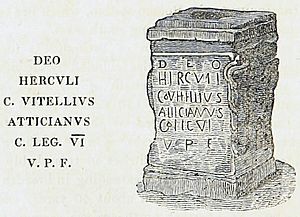
Messages carved on altars found at Epiacum tell us which Roman army groups were stationed there. One altar says: "To the god Hercules, Gaius Vitellius Atticianus, Centurion of the Legio VI Victrix, Loyal and Faithful, [erected this]." This was a regular army legion based in York.
Another altar says: "To the god Apollo, Gaius Julius Marcius, [commander] of the 2nd Cohort of Nervians, [fulfilled his vow]." This altar and two others also mention the 2nd Nervians. These were helper soldiers from the lower Rhine area. These inscriptions date from 213 to 221 AD. This altar was set in a large stone slab. The slab was held up by four columns, each with a coin on top. One of these coins was from 141–161 AD.
Discoveries at the Fort
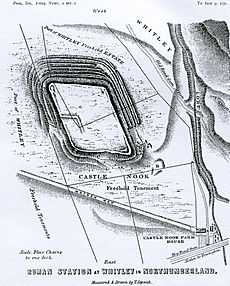
Not much archaeological digging has happened at Whitley Castle. In 1810, the Revd. John Hodgson dug up the bath house. This was in the north-east corner of Epiacum. In 1825, many leather shoes were found. They were in a Roman rubbish dump. A man named Mr. Henderson found them while digging a drainage ditch.
The geologist Thomas Sopwith surveyed the fort in 1833. He described the fort, its baths, and the midden (waste heap). He wrote that the Roman rubbish heap had provided "many loads of excellent manure" for nearby fields. He also said it was a "productive mine of several interesting curiosities."
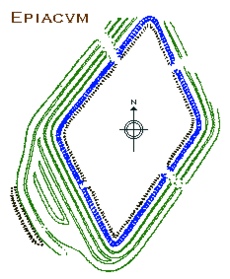
R.G. Collingwood also surveyed the fort. He described it in his 1930 book, Archaeology of Roman Britain. He pointed out the fort's unique skewed shape. He also noted the extraordinary defensive ramparts on the western, uphill side. Pottery found in the 1950s suggests the fort was built in 122 AD. This was around the same time as Hadrian's Wall.
A survey in 2007–2008 by English Heritage found a large Roman civilian settlement. This settlement, called a vicus, was north and west of the fort. Things found there include coins, pottery, glass, and objects made of jet. Inscribed stones were also discovered.
In 2012, the University of Durham used geophysics to survey the site. This was part of an English Heritage project. Since there hasn't been a full excavation, archaeologists have used a clever method. They sift through earth dug up by moles in their molehills. This has helped them find Roman artifacts. Finds include pieces of terra sigillata (Roman table pottery). They also found parts of serving bowls and earthenware pots. A bead made of jet, some iron nails, and a bronze dolphin from the bath house were also discovered. The dolphin was likely a handle for a tool like a strigil or razor.
Protecting the Past
The site of Whitley Castle is on private land, Castle Nook Farm. It is protected as a Scheduled Ancient Monument. In 2012, a non-profit group called Epiacum Heritage Ltd. received a grant. This money was from the Heritage Lottery Fund. It was used to create events for the fort. These events include a website, guided tours for the public, and archaeology survey days for volunteers. They also offer educational events for schools.
See also
 In Spanish: Whitley Castle para niños
In Spanish: Whitley Castle para niños


